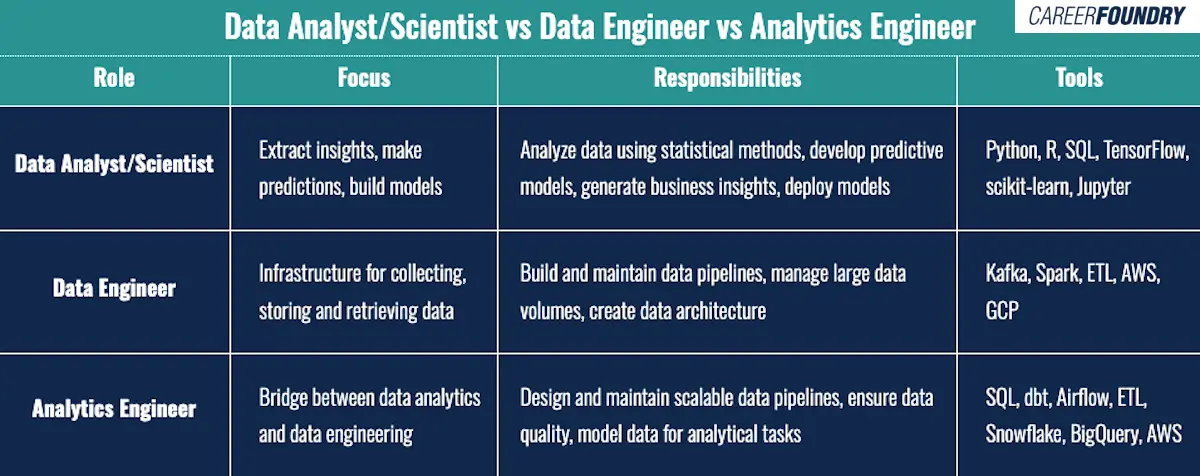Analytics engineering lies at the intersection of data science and data engineering. While this field is relatively new, its foundations lie in the fundamentals of data handling, processing, and interpretation. For newcomers to the world of data, understanding analytics engineering is essential.
It not only hints at how the data ecosystem is evolving but also underscores the growing importance of understanding the entire data stack, from data collection and transformation, to analysis and actionable insights.
I’ll unpack the history of this exciting field and discuss career pathways!
- What is analytics engineering?
- What is an analytics engineer?
- Analytics engineer vs data engineer: What’s the difference?
- How to become an analytics engineer
- Final thoughts
1. What is analytics engineering?
Analytics engineering is closely related to data analytics, data science, and data engineering. It emerged at the intersection of these domains, and aimed to streamline the process of data transformation. At its core, analytics engineering bridges the technical and analytical sides of data.
Analytics engineers are responsible for crafting reliable pipelines, modeling data in ways that make it accessible and actionable, and ensuring that the data is of high quality. They work with the raw data and transform it into a format that downstream users can use. Their impact is quite large as many of their users include data analysts, data scientists, machine learning engineers, and business users.
Where did analytics engineering come from?
Data analytics is focused on the process of transforming raw data into actionable insights. Historically, however, this process was fragmented. Data scientists focused on advanced modeling to uncover insights and patterns. Data engineers built and maintained the infrastructure and pipelines required to store, manage, and deliver data downstream for analysis.
It has become increasingly complex to understand this data, and there was a need for a role that could bridge the technical complexities of data engineering with the analytical rigor of data science. The demand for real-time data processing and agile data operations also revealed a gap in the market.
Enter the analytics engineer: they not only understand data infrastructure but also appreciate the nuances of data analysis. They design and maintain scalable data workflows, ensure data integrity, and create user-friendly platforms for data use.
We can trace the role’s origins to Fishtown Analytics, which developed a tool called dbt, or data build tool. dbt was key to enabling data analysts to transform and model data in the data warehouse differently. They could perform these transformations directly in SQL, shifting the ETL (extract, transform, load) process to ELT (extract, load, transform) instead. dbt has nurtured an active and large community that shares best practices, creates open-source dbt packages, and collectively pushes analytics engineering forward.
Hence, analytics engineering is not just about gathering and storing; it’s about efficiently and effectively transforming data into a strategic asset.
2. What is an analytics engineer?
You can think of analytics engineering as someone who applies data science principles with the architectural expertise of a data engineer. They’re a hybrid professional and are typically focused on building robust and scalable data workflows to help other business functions confidently use their internal data assets.
In practice, an analytics engineer might craft SQL scripts to mold data into user-friendly tables, use tools like data build tool (dbt) to test and document data transformations, and work with platforms like Snowflake or BigQuery to ensure data is stored optimally for analysis. Their work ensures that when a data scientist or analyst queries data, the results are accurate, consistent, and timely.
Analytics engineers are expected to go beyond the technical to understand the business context they work in. They often collaborate with stakeholders to understand their data needs before creating models to ensure alignment with the company’s analytical priorities.
Analytics engineers can be found across industries. For example, an analytics engineer working in healthcare may be responsible for storing and transforming data transmitted by wearable devices that collect patient data in real-time. They would have to design a system that ingests data, cleans it (e.g. removes erroneous data), and enables a way for healthcare professionals to access it. One challenge they face is having to integrate data from many different sources and types, such as lab results and electronic medical records, for each patient profile.
3. Analytics engineer vs data engineer vs data scientist: What’s the difference?
One way to better understand how these roles are distinct but interrelated is to examine the specific tasks, tools, and objectives associated with each role in the data processing and analysis pipeline.
This table provides an overview, but keep in mind that roles may be slightly different based on specific industries, companies, or evolving technologies.

4. How to become an analytics engineer
Although there are many routes towards a career in analytics engineering, a typical path often involves a combination of technical training and hands-on experience.
If you’re not sure where to start, here’s a suggested roadmap that can structure your journey into this field.
Education
Formal education is not mandatory for many roles in tech, but it won’t hurt to have a bachelor’s degree in fields like Computer Science, Data Science, Information Systems, or Engineering.
It’s more important, however, to learn the tools and languages that analytics engineers use daily. SQL is fundamental for data querying. Dive into data warehousing solutions; pick from industry favorites such as Snowflake, Databricks, or Redshift.
In fact, I first learnt about analytics engineering through taking the free dbt Fundamentals course for beginners; there are more free advanced courses on refactoring SQL and materializations as well. You can even get formally certified in dbt through their exam, which is a great way to signal competence if you’re lacking in professional experience.
Key topics to understand
Beyond tools, you need to have a deep understanding of core topics, such as data modeling which involves structuring data more efficiently for analysis. You can learn more about how to get started with data modeling in our guide.
It’s also important to go beyond a superficial understanding of data infrastructure. Understand how data is stored, processed and moved across systems.
Hands-on experience
It’s one thing to learn new concepts through an online course or from a textbook, it’s quite another to apply them to a novel problem.
The best way to become an analytics engineer is to secure professional roles that allow you to get better at these skills. If you’re early in your career, try to secure internships or entry-level positions on data teams.
If you’re looking to transition into this role or reskill, try to take on projects at work that give you an opportunity to shadow and learn skills adjacent to analytics engineering. Learning on the job allows you to learn best practices from seasoned professionals and apply concepts to real-world challenges.
Build a portfolio
A portfolio serves as proof of work, that you have the skills and expertise to take on analytics engineering needs at any organization. It can be hard to acquire hands-on experience for roles before you attain them.
One way around this is to work on personal projects that mirror analytics engineering workflows, or by contributing to open-source projects. A GitHub repository is the best resume since employers can assess your coding skills directly. Check out CareerFoundry’s guide on how to craft a data analytics portfolio that will showcase your skills.
5. Final thoughts
The rise of analytics engineering signifies a shift in the way we approach data. Data science and data engineering are increasingly intertwined: as the complexities of data collection, storage, and analysis grow, the integration between these two domains has become essential to building robust analytical systems.
If the world of data analytics interests you but you don’t know where to start, why not try CareerFoundry’s Machine Learning with Python Course? It covers the basics of machine learning as a field through hands-on projects with an expert mentor, and will give you a good idea of whether or not it’s a career path you’re interested in pursuing further.
You may also be interested in the following articles:
